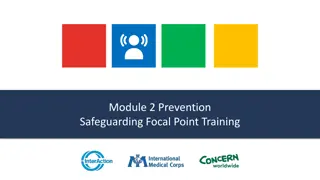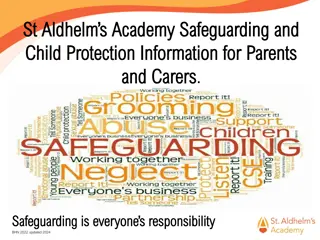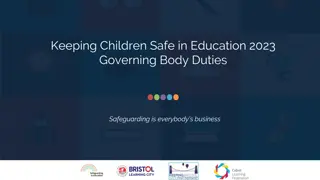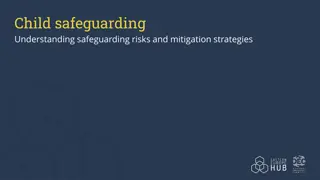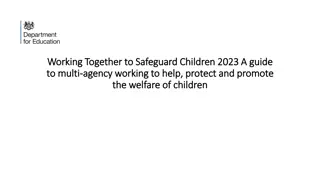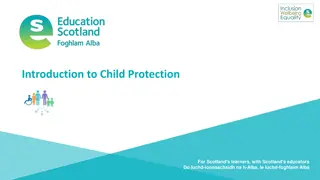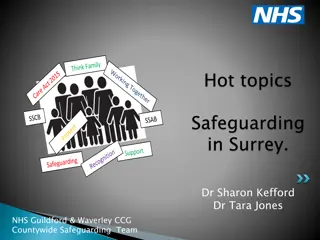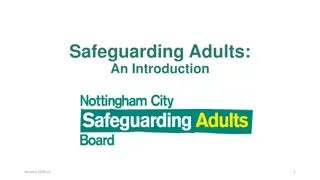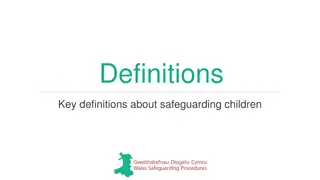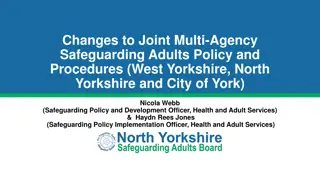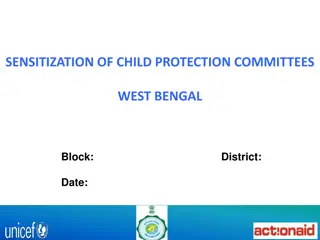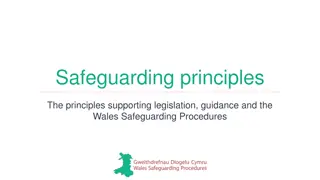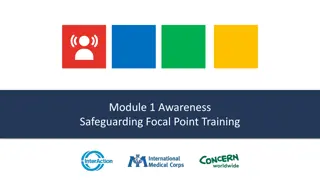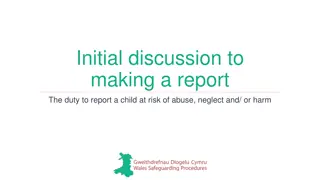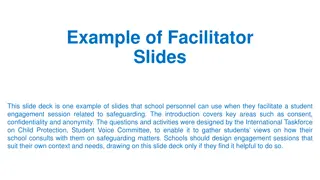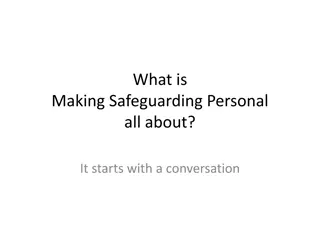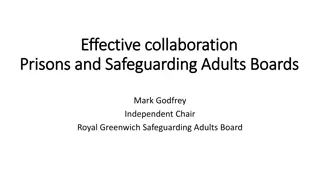Safeguarding and Child Protection Training Overview
Session focuses on recognizing, responding, reporting, and recording concerns about young individuals within The Boys Brigade. Includes discussions on safeguarding practices, safer recruitment procedures, and ongoing training for leaders.
Download Presentation

Please find below an Image/Link to download the presentation.
The content on the website is provided AS IS for your information and personal use only. It may not be sold, licensed, or shared on other websites without obtaining consent from the author.If you encounter any issues during the download, it is possible that the publisher has removed the file from their server.
You are allowed to download the files provided on this website for personal or commercial use, subject to the condition that they are used lawfully. All files are the property of their respective owners.
The content on the website is provided AS IS for your information and personal use only. It may not be sold, licensed, or shared on other websites without obtaining consent from the author.
E N D
Presentation Transcript
LEARNING OUTCOMES At the end of this session participants will be able to: Understand Safeguarding and Child Protection in the context of your role within The Boys Brigade Know how to Recognise, Respond to, Report and Record concerns about a young person
YOUR SAFEGUARDING TIMELINE When was the last time you did any safeguarding training? In the past 2 years ? In the past 5 years? Never?
YOUR SAFEGUARDING TIMELINE How confident are you in dealing with a safeguarding referral ? Very confident I know the policies, I know what to do and who to inform Fairly confident I know what to do and when but might need help withy the process Not very confident I would rather someone else did it Not at all confident I do not know what I would need to do
E-LEARNING RECAP Safeguarding is the measures and actions that are taken to promote the welfare of children and protect them from harm WHOLE GROUP ACTIVITY: Questions . . .
E-LEARNING RECAP What does the BB do to ensure Safer recruitment of leaders?
SAFER RECRUITMENT BB and Church of Scotland (CoS) Safer Recruitment Processes are designed to ensure only suitable leaders are appointed. They include: CoS Application form AND BB LREG1a form Interview Two references Protecting Vulnerable Groups (PVG) membership scheme Approval by Kirk Session And, since 2022, completion of BB Mandatory eLearning Modules all before they start in post.
E-LEARNING RECAP What Training & Development is provided for leaders?
TRAINING & DEVELOPMENT We have a culture of on-going training and development, this includes . . . Mandatory e-learning modules Youth Leader Training (YLT) Refresher & Other Themed Training Training as required by local Church
E-LEARNING RECAP What is the Leaders Code of Conduct?
LEADERS CODE OF CONDUCT Outlines the expectations we have of our leaders in relation to their behaviours and actions, including: Responsibilities Relationships & Boundaries Expected Good Practice Unacceptable Behaviour
E-LEARNING RECAP What policies, procedures, and guidance do we have and where can you find these?
Some of our Policies and Guidance Safeguarding Policy Statement Safer Recruitment Whistleblowing Policy Leaders Code of Conduct Good Practice Guidance Position of Trust Guidance Guidance for Leaders facing safeguarding concerns/allegations Find online at boys-brigade.org.uk/safeguarding/ COS Safeguarding Policies and guidance can be found online at churchofscotland.org.uk/about-us/safeguarding-service
THE SAFEGUARDING ACT - CHURCH OF SCOTLAND Provides a framework to guide the Church s response when a concern is raised Includes safer recruitment, responsibilities of Presbyteries, Kirk Session, Safeguarding Co-ordinator and the Safeguarding Service Outlines requirements for training, record keeping and retention Advice given by the Safeguarding Service, when framed as an instruction, must be followed.
CHILD PROTECTION WHAT DOES THIS MEAN? This a part of safeguarding. It is the actual action and processes we undertake to protect individual children we suspect have suffered or are suffering harm.
DEFINITION OF CHILD & ADULT AT RISK In Scotland A child is a person under the age of 18 years for most safeguarding legislation, policies and guidance. An adult at risk is a person over the age of 16 that you suspect or know is being harmed or exploited by another person, or is harming themselves, and is unable to protect themselves.
RECOGNISING HARM & ABUSE SMALL GROUP ACTIVITY: Recognising Harm & Abuse Visit nspcc.org.uk Was there a type of harm you were unaware of? Is there anything you would struggle with? Would you feel uncomfortable hearing about some of these? Is there anything you don t understand? Are there any words you might find hard to say when passing it on?
HOW PREVALENT IS CHILD ABUSE IN THE UK? 1 in 5 adults experienced at least one form of child abuse / 8.5m people An estimated 3.1 million adults aged 18 to 74 years were victims of sexual abuse before the age of 16 years Around half of adults (52%) who experienced abuse as a child also experienced domestic abuse later in life, compared with 13% of those who did not experience abuse as a child Crime Survey for England and Wales 2019
THE 4 Rs - RECOGNISING SMALL GROUP ACTIVITY: Case Studies In groups consider each statement: On a scale of 1 10 (10 = greatest) rank case study based on how much harm is being caused to the child. Try to reach an agreement about the ranking and note down any reasons if you disagree.
THE 4 Rs Things to consider: Has the child/young person been abused/harmed? What type of harm/abuse is this? Has a crime been committed? What are you going to do? Remember to rank each case study on a scale of 1 10 (10 = greatest)
CASE STUDY 1 You are a leader in your Company. One of the young people attends BB with a mark on his face. He tells you his teaching assistant did it at school today. He hasn t told his parents as they were busy earlier, and did not notice the mark.
CASE STUDY 1 Republic of Ireland - On 11th December 2015 the reasonable punishment defence was abolished. Children First Act 2015 The Law Currently England and Northern Ireland Wales - The Welsh Assembly agreed to remove the reasonable punishment defence, and this became law on 21st March 2022. Children Act 2020 It is unlawful to assault a child? There is a defence of reasonable punishment, only if you are the parent/carer. This defence can only be used if: Scotland - In 2017 the Government agreed to consider banning smacking. Legislation was agreed in October 2019. This became law in November 2020. Children (Equal protection from Assault) Scotland Act 2019 1. There is no lasting mark 2. The circumstances are reasonable Section 58 Children Act 2004
CASE STUDY 2 You are the OIC for Juniors. A parent has contacted you and stated their child was kicked by a leader last week and they have reported it to the police today. Your Company meets tomorrow night.
CASE STUDY 3 An Anchor always comes to BB late. They often do not have the correct uniform. They look scruffy, and sometimes appear smelly and unwashed. You notice other children make fun of them.
1 in 10 children have experienced neglect NEGLECT - NSPCC Neglect can be a lot of different things, which can make it hard to spot. But broadly speaking, there are 4 types of neglect: PHYSICAL - A child's basic needs, such as food, clothing or shelter, are not met or they aren t properly supervised or kept safe. EDUCATIONAL - A parent doesn't ensure their child is given an education. EMOTIONAL - A child doesn't get the nurture and stimulation they need. This could be through ignoring, humiliating, intimidating or isolating them. MEDICAL - A child isn't given proper health care. This includes dental care and refusing or ignoring medical recommendations. Signs of neglect can be really difficult to spot. Having one of the signs doesn't necessarily mean a child is being neglected. But if you notice multiple signs that last for a while, they might show there's a serious problem.
CASE STUDY 4 You are the Captain. One of your leaders has just informed you about a relationship between two people in your Company, one of which is a female leader aged 18. The young person is a male aged 16 (nearly 17).
CASE STUDY 4 In terms of Position of Trust : Current legislation (laws) Legislation is being expanded Regional variations BB guidance for leaders You can find our Position of Trust guidance at boys-brigade.org.uk/position-of-trust/
CASE STUDY 5 You recently become a leader after helping at your local BB group for a year. You have just completed the YLT Safeguarding Module and realised that some things in your Company are not done correctly. Helpers attend for several weeks/months, before they complete leader registration processes. Leaders often join in football and other contact games. You spoke about the training to your Captain. He explained that we need to see how helpers fit in before they join properly. Some of the rules are ignored because they don t work for every Company.
LEADERS CODE OF CONDUCT Outlines the expectations we have of our leaders in relation to their behaviours and actions, including: Responsibilities Relationships & Boundaries Expected Good Practice Unacceptable Behaviour You can find the Leaders Code of Conduct at boys-brigade.org.uk/safeguarding/
CASE STUDY OVERVIEW How hard was it to agree the level of harm? What helps us make a decision? Is there always a correct answer? How do we get it right?
CASE STUDY 6 Adults at risk Colin is a 19-year old young man whose sight is very poor; he can barely make out shadow images of objects. He is a very intelligent and sensitive young man, and a very proficient computer user. He is currently training to use a guide dog. He has a history of falls and injuries caused by walking into things and when he comes into Church with a large bruise on his face you remark lightly about it; however, he seems quite anxious and responds that it was his own fault he should not have knocked over his mother s boyfriend s beer. He then starts sobbing quietly and will not say anything more, only shaking his head when you try to talk to him further.
CASE STUDY 6 Consider the following Is this a situation where harm may be occurring; if so what type of harm? What can you do? What should you do? What should you not do? Who else should be involved? What else should be considered?
THE 4 Rs - RESPONDING How might you respond to a concern raised by a child/young person? SMALL GROUP ACTIVITY: Responding to Concerns
RESPONDING How might you respond ?
BARRIERS TO RESPONDING What might prevent a leader responding appropriately and not reporting an allegation? SMALL GROUP ACTIVITY: Barriers to responding
THE 4 Rs - RESPONDING An allegation or concern is often made unexpectantly. Plan now . . . Know where to find the BB Safeguarding Procedures. Have a read of them. Find out who your Church Safeguarding Lead/Co-ordinator is. Know where to find your Church Safeguarding Policy and read it. Ensure you have contact numbers for your Captain, Chaplain, BB Safeguarding Manager (0300 303 4454 or safeguarding@boys-brigade.org.uk). Put it in your phone now!
Report as soon as possible, always within 24 hours THE 4 R s REPORTING (PASS IT ON) Non Emergency Emergency
REPORTING REGIONAL DIFFERENCES In non urgent circumstances following consultation with the Safeguarding Service, the Safeguarding Co-ordinator and/or BBHQ Safeguarding Manager will take responsibility for referring to Statutory Agencies. E&W Police, Social Services Lado/Mash, Police, NSPCC, Childline Northern Ireland - Police, PSNI, NSPCC , Health and Social Trust Gateway ROI - Police, Tusla Child and family agency Scotland - Police, NSPCC, Local Social work team, Children s reporter
Safeguarding in the Church of Scotland Protecting children and adults at risk RECOGNISE REPORT PROTECT If you suspect or witness harm or abuse, or it is reported to you, you must immediately report it to your Safeguarding Coordinator: .. who will then contact the Safeguarding Service. Harm/abuse includes risk of harm , historical abuse and risk posed by a sex offender attending worship. For more information: http://www.churchofscotland.org.uk/about_us/safeguarding_service 2015 SAFEGUARDING CO-ORDINATOR In the Church of Scotland the congregation Safeguarding Co-ordinator details will be on a sign like this. It s important that you know this as well as the contact details for the BBHQ Safeguarding Manager.
1. CHURCH OF SCOTLAND SAFEGUARDING CO-ORDINATOR Appointed and trusted by the Kirk Session (trustees who have ultimate legal responsibility for safeguarding)to: Act as the named lead person for Safeguarding in a congregation and deal with concerns about suspected, witnessed or reported harm Understand the Church s safeguarding policies and procedures (Safeguarding Handbook; pocket guide) Manage & lead the safer recruitment of workers including maintaining the Congregational Safeguarding Register (SG7)
2. CHURCH OF SCOTLAND SAFEGUARDING CO-ORDINATOR Appointed and trusted by the Kirk Session (trustees who have ultimate legal responsibility for safeguarding)to: Implement and maintain good practice in the recruitment, assessment, training, management and support of staff/volunteers Advise Kirk Session about safeguarding matters such as changes in national or Church policy Support the management of those who pose a risk (usually sex offenders but also some people who have a history of violent offending or serious mental health challenges)
THE 4 Rs - RECORDING You should . . . Write down what was said as soon as possible. Detail who the concern is about, what the concern is and what happened. Use the child s words - include any questions that were asked, and the answers given. As a leader, write down anything you have seen or heard, including details of any witnesses. Include who you have spoken to, when, and include their contact details. Include any history about the child or family that could be relevant. Complete your report as soon as possible after the event.
CAN WE ASK QUESTIONS WHEN RESPONDING TO A DISCLOSURE? Necessary to establish whether or not there is a concern. Non leading - don t suggest an answer. Open Avoid questions that invite only YES or NO answers. Use TED: TELL ME EXPLAIN DESCRIBE
TELL ME WHAT HAPPENED I was on a school trip, at the park and fell off the climbing frame. Miss was amazing. She grabbed me and stopped me landing on the floor. Her nail caught my face. My head would have have exploded if I hit the deck. I pushed a girl over in the play ground. Miss grabbed my arm and dragged me to the time out area. My head banged on the door as we went inside. She was really cross with me. I made the girl cry. Child Child You now have enough information and an understanding of what has happened.
YOUR ACCOUNT I am Leader-in-Charge for Juniors with 1st Anywhere Company. On Monday 15th October we were designing posters for our fundraising event. The young people were at tables in groups of 4. I saw JP had a mark on his face. The mark was across his cheek bone, and under his eye area. It looked red in appearance. I asked him How did that happen He said My teacher did it . I then asked Tell me what happened? . He said I pushed a girl over in the playground. Miss grabbed my arm and dragged me to the time out area. My head banged on the door handle as we went inside. She was really cross with me. I made the girl cry. During the snack break I spoke to the Captain and told him what had happened. He told me he would take responsibility for this. He asked me to make notes of what JP said and asked me to write this account straight away. JP has been with us for 2 years. He lives with his parents and younger brother. He attends Anywhere Primary School. Signed .dated .
ONLINE REPORTING FORM The best way to report a safeguarding concern or allegation is to use our BBHQ reporting form at boys-brigade.org.uk/safeguarding/
YOUR ROLE ALWAYS inform your Safeguarding Coordinator & BB Safeguarding Manager of any safeguarding concern or allegation about a BB Volunteer or young person as soon as possible, but always within 24 hours. We can all play a part in keeping children safe. Remember: Safeguarding is everyone s responsibility. The 4 R s Recognise, Respond, Report & Record. Always maintain appropriate boundaries with children & young people. Regularly familiarise yourself with our latest polices and procedures. safeguarding@boys-brigade.org.uk or 0300 303 4454 If in any doubt, seek advice!
YOUR SAFEGUARDING TIMELINE How confident are you now, in dealing with a safeguarding referral ? Very confident I know the policies, I know what to do and who to inform Fairly confident I know what to do and when but might need help withy the process Not very confident I would rather someone else did it Not at all confident I do not know what I would need to do
LEARNING OUTCOMES At the end of this session participants will be able to: Understand Safeguarding and Child Protection in the context of your role within The Boys Brigade Know how to Recognise, Respond to, Report and Record concerns about a young person.


